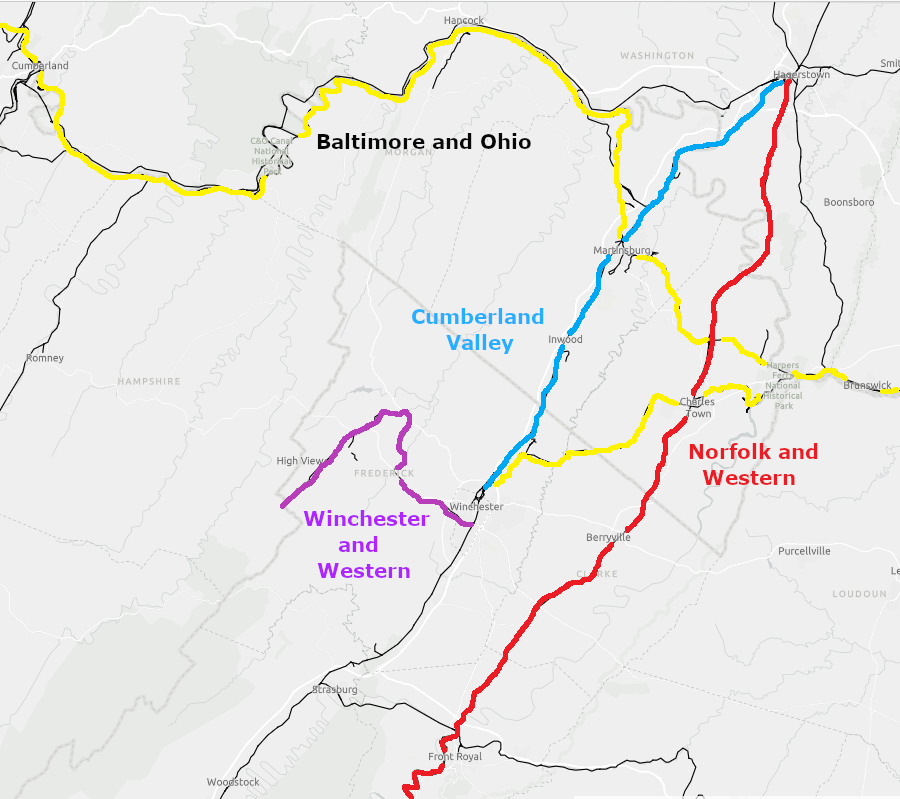
the Cumberland Valley Railroad linked Hagerstown to Winchester in 1889, and is now part of the Winchester and Western Railroad (built later in 1916)
Source: ESRI, ArcGIS Online

the Cumberland Valley Railroad linked Hagerstown to Winchester in 1889, and is now part of the Winchester and Western Railroad (built later in 1916)
Source: ESRI, ArcGIS Online
The Cumberland Valley and Martinburg Railroad built south to Winchester in 1889, using a charter originally issued for the Martinsburg & Potomac Railroad. When the Martinsburg and Potomac Railroad was sold in foreclosure in 1888, it was acquired by the Cumberland Valley Railroad based in Chambersburg, Pennsylvania.
The Pennsylvania Railroad was providing the financing and in control of the different railroads, no matter what their name. The Cumberland Valley Railroad leased the Cumberland Valley and Martinburg Railroad in 1888 for 99 years. Lawyers recognized the differences between corporate names, but to ordinary people the new railroad operating between Winchester and Martinsburg/Hagerstown was the Cumberland Valley Railroad.
The Pennsylvania Railroad had acquired majority ownership of the Cumberland Valley Railroad in 1859, but left it as a separate corporation. The distinctions between the various corporations that operated the trains from Winchester to Hagerstown were rarely relevant until finally, in 1919, the Cumberland Valley Railroad was merged into the Pennsylvania Railroad.1
"An Act to Authorize the Merger of the Martinsburg and Potomac Railroad Company Into the Cumberland Valley and Martinsburg Railroad Company," December 19, 1889, in Acts of the General Assembly of the Commonwealth of Virginia, Commonwealth of Virginia, 1890, pp.15-16, https://books.google.com/books?id=6L1OAQAAIAAJ; "About Winchester And Western Railroad Company," OmniTrax, http://omnitrax.com/our-company/our-railroads/winchester-and-western-railroad-company/; "Winchester & Western Railroad," American-Rails.com, https://www.american-rails.com/winchester.html; Christopher T. Baer, "1889" and "1919" in "A General Chronology Of The Pennsylvania Railroad Company
Predecessors And Successors And Its Historical Context," Pennsylvania Technical and Historical Society, http://www.prrths.com/newprr_files/Hagley/PRR_hagley_intro.htm; William Bender Wilson, History of the Pennsylvania Railroad Company: With Plan of Organization, Portraits of Officials and Biographical Sketches, Volume 1, Henry T. Coates, 1899, pp.396-397, https://books.google.com/books?id=qj9N-eWi71YC; "Annual Report of the State Corporation Commission of Virginia. Compilations from Returns of Railroads, Canals, Electric Railways and Other Corporate Companies," Virginia State Corporation Commission, 1917, p.145, https://books.google.com/books?id=BN8lAQAAIAAJ; Interstate Commerce Commission Reports: Reports and Decisions of the Interstate Commerce Commission of the United States, Volume 103, Government Printing Office, 1926, p.776, https://books.google.com/books?id=k91DAAAAIAAJ (last checked April 4, 2020)
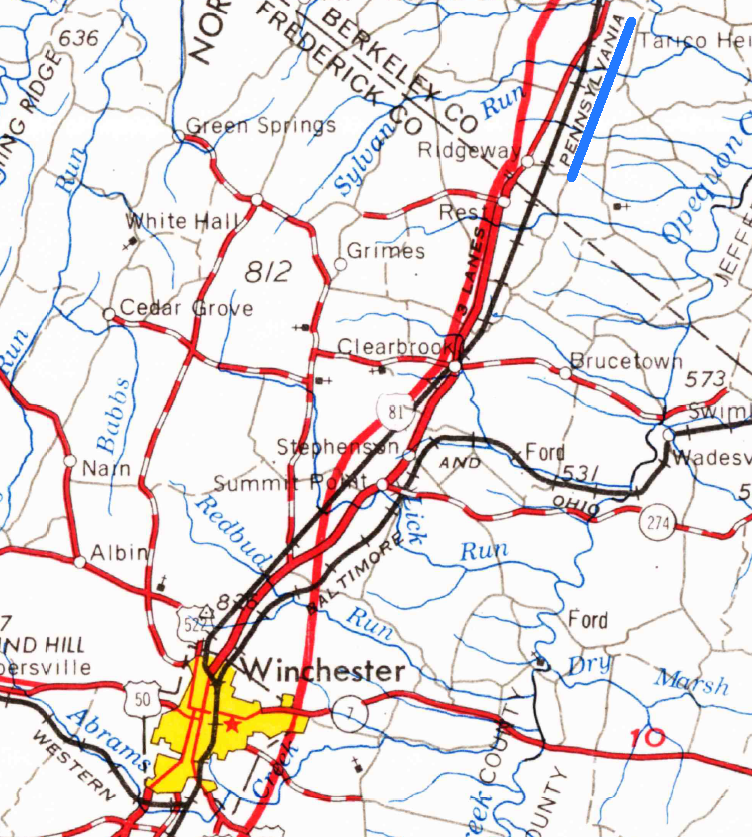
the Pennsylvania Railroad absorbed the Cumberland Valley Railroad in 1919
Source: US Geological Survey (USGS), Cumberland MD 1:250,000 topographic quadrangle (1952)
The Cumberland Valley Railroad originally built east in Pennsylvania from Chambersburg to Harrisburg, on the Susquehanna River. The owners had dreams of that route being chosen for the integrated railroad replacement of the fragmented system of canals, inclined planes, and railroads on the Main Line of State Works between Philadelphia-Pittsburg in 1834. However, the most suitable route ran west to Pittsburgh ran through the Juniata Valley; the Pennsylvania Railroad was completed north of the Cumberland Valley in 1852.1 Paul J. Westhaeffer. History of the Cumberland Valley Railroad, 1835-1919, Washington DC Chapter, National Railway Historical Society, 1979, p.4. p.7, pp.35-37
A precursor of the Cumberland Valley Railroad, the Franklin Railroad Company, built west from Chambersburg to Hagerstown in 1840. Between 1870-1873, the Martinsburg and Potomac Railroad constructed track to the Potomac River, with a bridge across the river to Martinsburg in West Virginia. The connection between Martinsburg-Winchester, which opened in 1889, ended up being the last extension orchestrated by the Cumberland Valley Railroad in Virginia.1
William Bender Wilson, History of the Pennsylvania Railroad Company: With Plan of Organization, Portraits of Officials and Biographical Sketches, Volume 1, Henry T. Coates, 1899, pp.396-397, https://books.google.com/books?id=qj9N-eWi71YC (last checked June 2, 2020)
The extension to Winchester had been proposed in 1880, when the the Cumberland Valley Railroad was negotiating with the new Shenandoah Valley Railroad to interchange at Hagerstown. The Shenandoah Valley Railroad had the alternative of sending its traffic northeast via the Baltimore and Ohio Railroad, which was the great rival of the Pennsylvania Railroad and therefore of the Cumberland Valley Railroad.
When negotiations were at an impasse between the Cumberland Valley Railroad and the Shenandoah Valley Railroad, both proposed to build tracks parallel to the other's line and to compete rather than interchange cars. The Cumberland Valley Railroad announced it would build new track from Martinsburg to Winchester. An interchange there with the Baltimore and Ohio (B&O) Railroad would eliminate any need for the Cumberland Valley Railroad to deal with the Shenandoah Valley Railroad. In 1880, the B&O controlled the track south of Winchester to Staunton, and was financing the Valley Railroad's extension south to Salem. A combination of the Cumberland Valley Railroad and the Baltimore and Ohio Railroad could transport southern cotton through Virginia, West Virginia, Maryland, and Pennsylvania to northern mills, on a line west of the track being completed by the Shenandoah Valley Railroad.
In return, the Shenandoah Valley Railroad announced plans to build track from Hagerstown to Harrisburg, the eastern endpoint of the Cumberland Valley Railroad. That expansion would create a competitor in Pennsylvania to the Cumberland Valley Railroad.
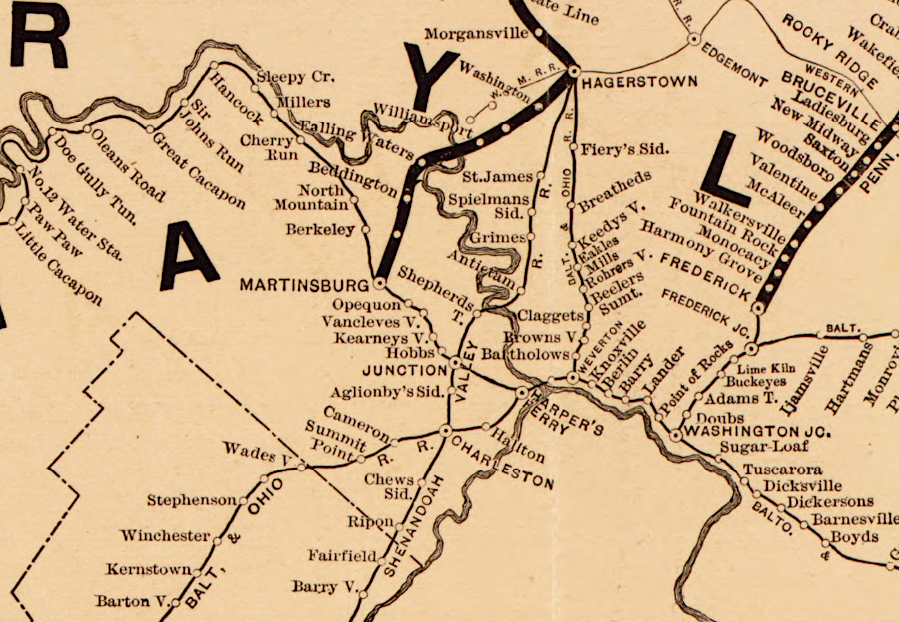
the Cumberland Valley Railroad built to Martinsburg in 1873, and to Winchester in 1889
Source: Library of Congress, Map of the Pennsylvania, Reading, and Lehigh Valley Railroads, and their connections
Neither plan would have been a cost-effective investment; both were negotiating tactics. When a deal was finally reached in 1883, the Cumberland Valley Railroad committed to use 20% of the revenue from interchanged traffic to purchase stock in the Shenandoah Valley Railroad. The negotiations reveal the limited control of the Pennsylvania Railroad despite its substantial ownership in both the Cumberland Valley Railroad and the Shenandoah Valley Railroad. The Cumberland Valley Railroad leaders could threaten to partner with one of the Pennsylvania Railroad's greatest rivals, Baltimore and Ohio Railroad, in order to obtain better rates for interchanging traffic with the Shenandoah Valley Railroad.
Six years later, the Cumberland Valley Railroad built track from Martinsburg to Winchester just to acquire local traffic. The extension in 1889 was a dead-end branch. It did not increase the possibility of creating a major north-south through-route for the Pennsylvania Railroad. Paul J. Westhaeffer. History of the Cumberland Valley Railroad, 1835-1919, Washington DC Chapter, National Railway Historical Society, 1979, p.
Building south into the Shenandoah Valley was a part of the Pennsylvania Railroad's competition with the Baltimore & Ohio (B&O) Railroad. The B&O had built the Winchester and Potomac Railroad from Harpers Ferry to Winchester in 1836. The 1889 "Martinsburg & Potomac Railroad" extension to Winchester came after other Pennsylvania Railroad efforts to control freight and passenger traffic had not succeded.
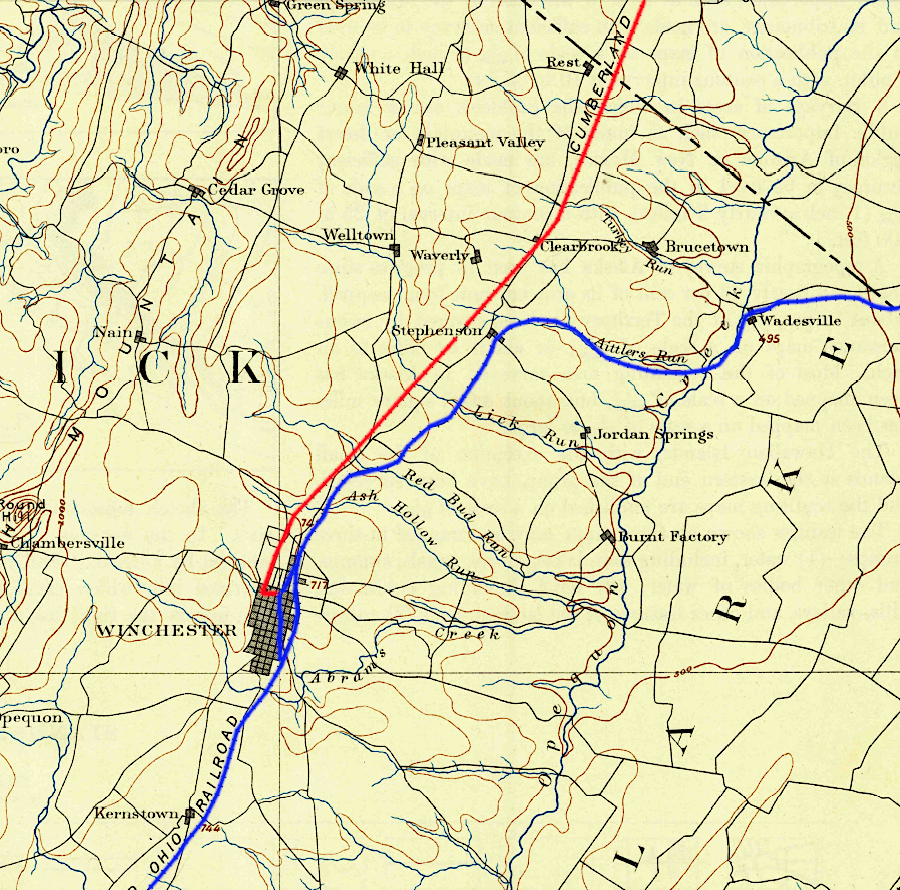
the Pennsylvania Railroad extended the Cumberland Valley Railroad (red) to Winchester in 1889, competing with the Baltimore and Ohio Railroad (blue)
Source: US Geological Survey (USGS), Winchester, WV 1:125,000 topographic quadrangle (1894)
After the Civil War, the Virginia General Assembly chartered the Valley Railroad. It was built on the west side of Massanutten Mountain south from Harrisonburg. The Baltimore and Ohio (B&O) Railroad purchased enough stock to ensure control, and its investment financed construction.
At the same time, the Winchester and Strasburg Railroad built track that finally closed the gap between Winchester and Strasburg, and the B&O leased it. The B&O also leased the other railroad which had the right to operate between Strasburg-Harrisonburg.
The B&O was financially stretched, but it ended up with control of track on the western side of the Shenandoah Valley stretching between Harpers Ferry and the southern end of the Valley Railroad. As soon as the Valley Railroad finished construction to meet the Virginia and Tennessee Railroad near Salem, the B&O would be able to pull traffic from the south to Baltimore by way of Winchester to the main liine running through Harpers Ferry.
However, the Valley Railroad was never completed south of Lexington.
The Pennsylvania Railroad sponsored a competing line through the Shenandoah Valley, the Shenandoah Valley Railroad. The Shenandoah Valley Railroad was built east to Winchester, but the Pennsylvania Railroad also pursued building a separate line south of Hagerstown through Winchester towards Staunton.
In 1873 the Cumberland Valley Railroad laid track from Hagerstown to the Potomac River, and the Martinsburg and Potomac Railroad built track further south from that spot on the Potomac River to Martinsburg.
Like the Baltimore and Ohio Railroad, the Pennsylvania Railroad worked through a variety of separately-chartered corporations. By purchasing sufficient amount of stock, the main railroads could appoint directors for the technically-independent corporations which had obtained charters from the legislatures of different states. It was politically expedient to keep some local business leaders on the boards of the separate corporations, as the Pennsylvania Railroad and Baltimore and Ohio Railroad expanded their systems.
The Shenandoah Valley Railroad started at the Pennsylvania Railroad's line in Hagerstown, Maryland. It too planned a southern junction with the old Virginia and Tennessee Railroad, also near Salem because topography favored that area. In 1882 the Shenandoah Valley Railroad, with funding from northern investors, completed construction to its junction; it grew quickly into the city of Roanoke.
The Pennsylvania Railroad lacked the capital to fund all of its expansion projects. Other investors acquired control of the old Virginia and Tennessee Railroad and the Shenandoah Valley Railroad, and then merged the two into the Norfolk and Western Railroad. That change left the Pennsylvania Railroad as a minority owner. It received substantial dividends, but was unable to control traffic and ensure business increased at Philadelphia rather than Baltimore.
When the Pennsylvania Railroad extended the Cumberland Valley Railroad to Winchester, it did not gain the opportunity to intercept coal traffic already coming from the Appalachian Plateau fields through the Shenandoah Valley. The Shenandoah Valley Railroad (by 1889 part of the Norfolk and Western Railroad) had bypassed Winchester when it built north of Front Royal to Hagerstown.
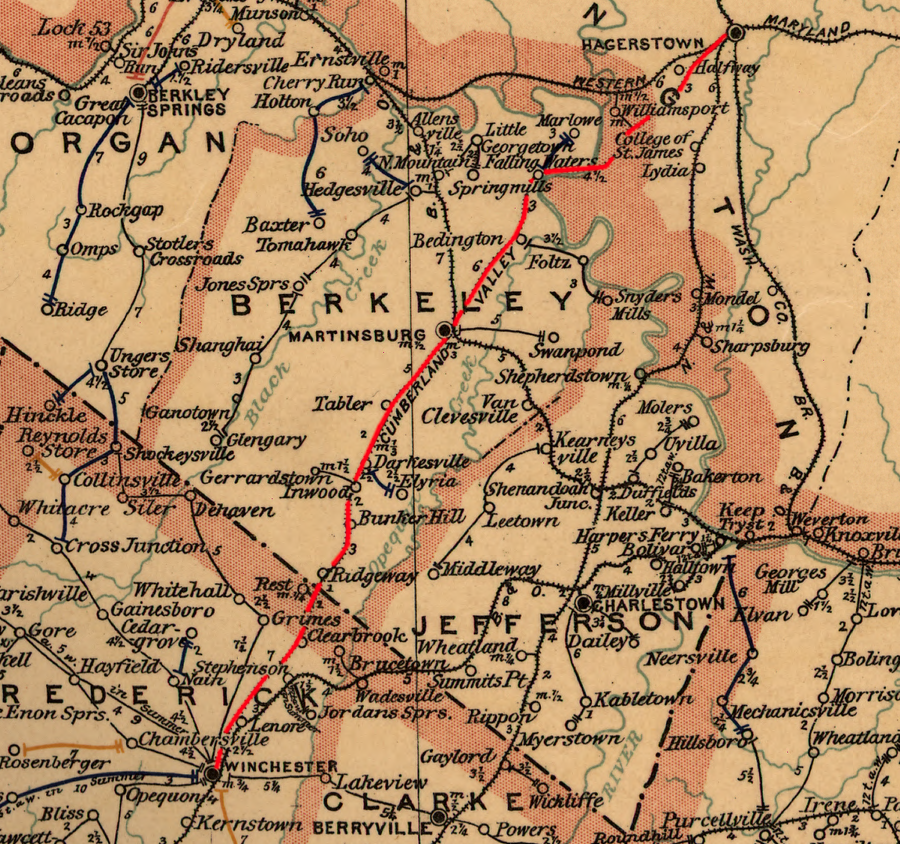
the Pennsylvania Railroad extended the Cumberland Valley Railroad to Winchester
Source: Library of Congress, Post route map of the state of Virginia and West Virginia (1896)
The Pennsylvania Railroad sought multiple ways to expand its network into the southern states, but the extension of the Cumberland Valley Railroad into the Shenandoah Valley ended at Winchester. Instead, the Pennsylvania relied upon its substantial investment in the Norfolk and Western to generate profits from that part of Virginia.
The Pennsylvania Railroad already had an interchange with the Norfolk and Western Railroad at Hagerstown, so financing expansion to Winchester was based on expectations of generating revenue from increased local traffic..2
"The Valley Railroad," Abandoned Rails, http://www.abandonedrails.com/Valley_Railroad; "Penn Central Transportation Company," American-Rails.com, https://www.american-rails.com/pc.html (last checked April 5, 2020)
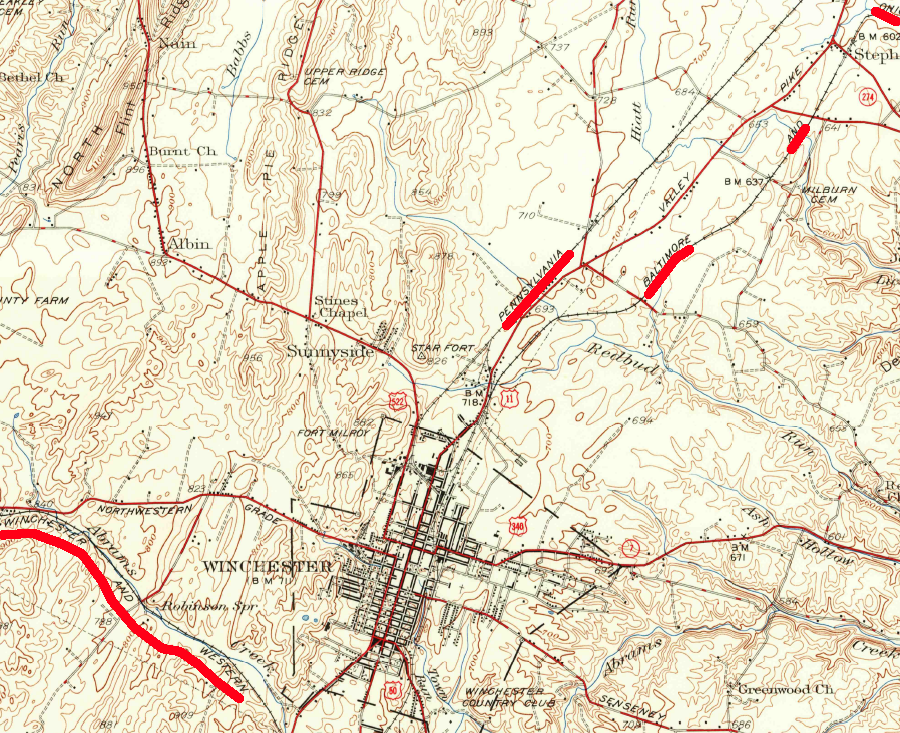
the Pennsylvania, Balitmore and Ohio, and Winchester and Western railroads served Winchester in 1942
Source: Library of Congress, Winchestr, VA 1:62,500 topographic quadrangle (1942)
After the 1968 merger of the Pennsylvania Railroad with the New York Central, the Penn Central operated the Martinsburg-Winchester track. The Penn Central lasted only two years before going bankrupt. In 1976, it was reorganized as Conrail. In creating Conrail, the US Railway Association determined that operations on the Hagerstown-Winchester track could be profitable.3
"Preliminary System Plan," US Railway Association, Federal Register, March 4, 1975, pp.9836-38, p.10147, https://books.google.com/books?id=P7uGS8wODlwC (last checked July 6, 2020)
Conrail later decided to abandon the Hagerstown-Winchester track. In 1986, it sold it to the Winchester & Western Railroad acquired the 35 miles. The Winchester and Western's major customer, the sand quarry in Gore, wanted to maintain the link to the Norfolk and Western railroad at Hagerstown. The alternative was to rely upon the Baltimore and Ohio Railroad (by that time part of the Chessie System) and ship via Harper's Ferry, without any opportunity to negotiate competitive rates.
The Winchester and Western Railroad continues to operate on the old Cumberland Valley Railroad, but the terminal in Winchester has been sold.3
"Abandoned Rails of Winchester, Virginia," Abandoned Rails, http://www.abandonedrails.com/Winchester_Virginia; Edward A. Lewis, American Shortline Railway Guide, Kalmbach Publishing, Co., 1996, pp.337-338, https://books.google.com/books?id=3i6K_Nf9e2EC (last checked July 6, 2020)
The Cumberland Valley Railroad was merged into the Pennsylvania Railroad in 1919. The Pennsylvania Railroad retained a significant financial interest in the Norfolk and Western Railroad until divestiture was required to gain approval of the 1964 merger of the Norfolk and Western with the New York, Chicago & St. Louis (Nickel Plate) Railroad and the 1968 merger of the Pennsylvania and New York Central.2
"Cumberland Valley Railroad," Railroad.net, http://www.railroad.net/viewtopic.php?f=96&t=75480&start=0; "About Winchester and Western Railroad Company," OmniTrax, http://omnitrax.com/our-company/our-railroads/winchester-and-western-railroad-company/; "Why Choose Rail," Winchester and Western, http://winchesterwesternrr.com/ship-with-winchester-western/; The Penn Central and Other Railroads: A Report to the Senate Committee on Commerce, U.S. Government Printing Office, 1973, pp.322-323, https://books.google.com/books?id=mzr30uuJI4QC (last checked July 6, 2020)